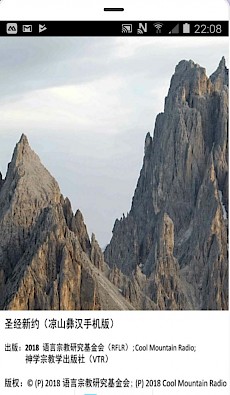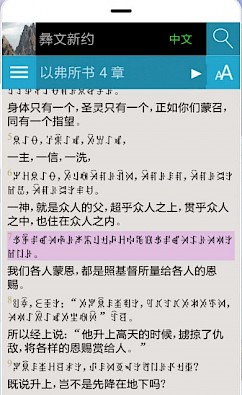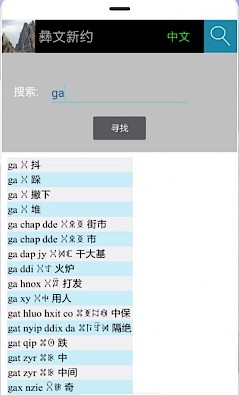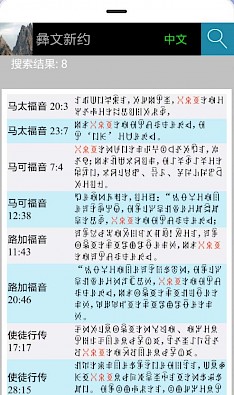Disclaimer: For security reasons, some person names mentioned on this webpage are pseudonyms.
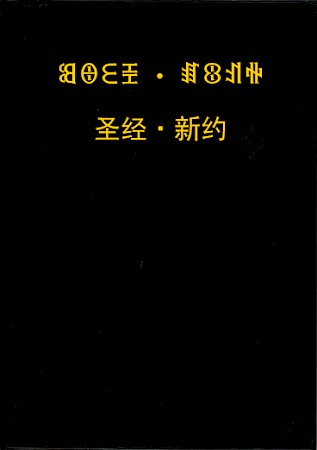 Nuosu New Testament, 1st, 2005Nuosu New Testament, First Print Edition, 2005; Nürnberg: Verlag für Theologie und Religionswissenschaft. ISBN: 3–937965–22–X.During the summer of 1996, Hans Grass of RFLR Germany commenced the Nuosu translation project with Shama Wuga, a Nuosu cultural worker based in Xīchāng 西昌 whose mother tongue is the Shynra dialect. In the beginning they used the Nuosu Pinyin for Bible translation, not the indigenous Nuosu characters, since the characters were available in Unicode and Windows only after 2000. Shama Wuga, Hans Grass and additional helpers translated a draft of the whole New Testament at the turn of 1997/1998, shortly before Hans Grass took his first furlough. Revisions restarted after 18 months and stopped again at the end of 1999, when Shama Wuga pursued studies overseas. Lamo Dage, a Nuosu school teacher speaking the Suondi dialect, replaced Shama Wuga and overhauled the manuscript of the New Testament during 2000. By November 2000, when Nuosu characters became available in Windows, the first round of revisions was completed and a computer program replaced all Pinyin syllables with the Nuosu indigenous characters for which Hans Grass had created a font. Back in 1996, Hans Grass engaged an art student of the Central University of Nationalities in Běijīng to design all 1119 Nuosu characters on paper, scanned them and asked a graphic company Běijīng to edit them with the Fontographer software. In 2000, assisted by the programmer Achim Gerber, Hans Grass implemented a Nuosu font in Windows 2000, called ‘Rotation Font’, which was later used for the print edition of the New Testament.
Nuosu New Testament, 1st, 2005Nuosu New Testament, First Print Edition, 2005; Nürnberg: Verlag für Theologie und Religionswissenschaft. ISBN: 3–937965–22–X.During the summer of 1996, Hans Grass of RFLR Germany commenced the Nuosu translation project with Shama Wuga, a Nuosu cultural worker based in Xīchāng 西昌 whose mother tongue is the Shynra dialect. In the beginning they used the Nuosu Pinyin for Bible translation, not the indigenous Nuosu characters, since the characters were available in Unicode and Windows only after 2000. Shama Wuga, Hans Grass and additional helpers translated a draft of the whole New Testament at the turn of 1997/1998, shortly before Hans Grass took his first furlough. Revisions restarted after 18 months and stopped again at the end of 1999, when Shama Wuga pursued studies overseas. Lamo Dage, a Nuosu school teacher speaking the Suondi dialect, replaced Shama Wuga and overhauled the manuscript of the New Testament during 2000. By November 2000, when Nuosu characters became available in Windows, the first round of revisions was completed and a computer program replaced all Pinyin syllables with the Nuosu indigenous characters for which Hans Grass had created a font. Back in 1996, Hans Grass engaged an art student of the Central University of Nationalities in Běijīng to design all 1119 Nuosu characters on paper, scanned them and asked a graphic company Běijīng to edit them with the Fontographer software. In 2000, assisted by the programmer Achim Gerber, Hans Grass implemented a Nuosu font in Windows 2000, called ‘Rotation Font’, which was later used for the print edition of the New Testament. 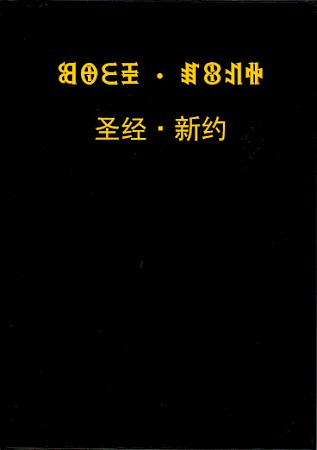 Nuosu New Testament, 2nd, 2009Nuosu New Testament, Second Print Edition, 2009; Nürnberg: Verlag für Theologie und Religionswissenschaft. ISBN: 978-3-933372-08-6.In August 2001 a new phase in the translation process opened when a group of Nuosu teachers including Munyo Vuhlur joined the project. Munyo Vuhlur of the standard Shynra dialect became the most important translator of the team. Over a period of six months, they checked, discussed and improved the New Testament. In two additional rounds, Munyo Vuhlur and Hans Grass updated a range of problematic key-terms. Revisions continued through 2002. In early 2004, one Nuosu translator read the New Testament to a group of farmers without Christian background. The text was completely intelligible to them, to the extent that they converted to the Christian faith when they read Chapter 7 of the Book of Revelation. During most of 2004, Munyo Vuhlur and Hans Grass went through an additional round of revisions and prepared the manuscript for publication. The New Testament was edited as a Nuosu / Chinese diglot using the logographic Nuosu script and the text of the Chinese Union Version (Hèhébĕn Version). The Verlag für Theologie und Religionswissenschaft in Nürnberg, Germany, published the New Testament in 2005 and had 5,000 copies printed in Hong Kong. As the distribution of these copies proceeded smoothly, a second, slightly revised edition was released by the same publisher in 2009 with 10,000 copies printed in Hong Kong. During 2011–2015, Mountain Radio recorded the New Testament as an audio version and in 2018 Hans Grass remixed and dramatised the audio files.
Nuosu New Testament, 2nd, 2009Nuosu New Testament, Second Print Edition, 2009; Nürnberg: Verlag für Theologie und Religionswissenschaft. ISBN: 978-3-933372-08-6.In August 2001 a new phase in the translation process opened when a group of Nuosu teachers including Munyo Vuhlur joined the project. Munyo Vuhlur of the standard Shynra dialect became the most important translator of the team. Over a period of six months, they checked, discussed and improved the New Testament. In two additional rounds, Munyo Vuhlur and Hans Grass updated a range of problematic key-terms. Revisions continued through 2002. In early 2004, one Nuosu translator read the New Testament to a group of farmers without Christian background. The text was completely intelligible to them, to the extent that they converted to the Christian faith when they read Chapter 7 of the Book of Revelation. During most of 2004, Munyo Vuhlur and Hans Grass went through an additional round of revisions and prepared the manuscript for publication. The New Testament was edited as a Nuosu / Chinese diglot using the logographic Nuosu script and the text of the Chinese Union Version (Hèhébĕn Version). The Verlag für Theologie und Religionswissenschaft in Nürnberg, Germany, published the New Testament in 2005 and had 5,000 copies printed in Hong Kong. As the distribution of these copies proceeded smoothly, a second, slightly revised edition was released by the same publisher in 2009 with 10,000 copies printed in Hong Kong. During 2011–2015, Mountain Radio recorded the New Testament as an audio version and in 2018 Hans Grass remixed and dramatised the audio files.
Android Smartphones
During 2018, Hans Grass, in cooperation with the programmer Moses Chen and the designer Jens Weigel, developed a mobile application for Android smartphones.
Website
Hans Grass, Moses Chen and Jens Weigel, also developed a web application. Personal and place names are marked in color in both applications. Both programs allow synchronous playback of the audio files and movement of the verse focus. Both applications integrate a list of 4,000 key terms which can be searched in the New Testament.
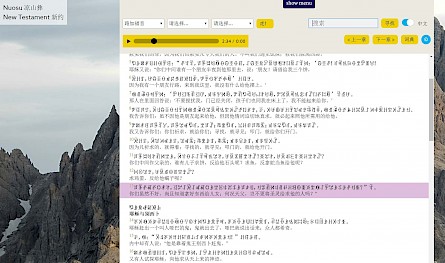 Synchronous Playback Nuosu New Testament 凉山彝语圣经新约; Text and Audio Web Application 网络版; Published 出版 2018: VTR 神学宗教学出版社; © (P) RFLR 语言宗教研究基金会; (P) Cool Mountain Radio; ISBN: 978-3-947306-24-4; DOI: 10.23771/9783947306244.
Synchronous Playback Nuosu New Testament 凉山彝语圣经新约; Text and Audio Web Application 网络版; Published 出版 2018: VTR 神学宗教学出版社; © (P) RFLR 语言宗教研究基金会; (P) Cool Mountain Radio; ISBN: 978-3-947306-24-4; DOI: 10.23771/9783947306244.
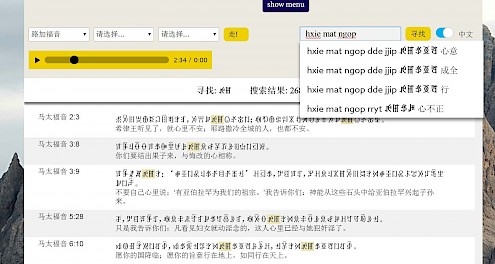 Built-in Dictionary
Built-in Dictionary
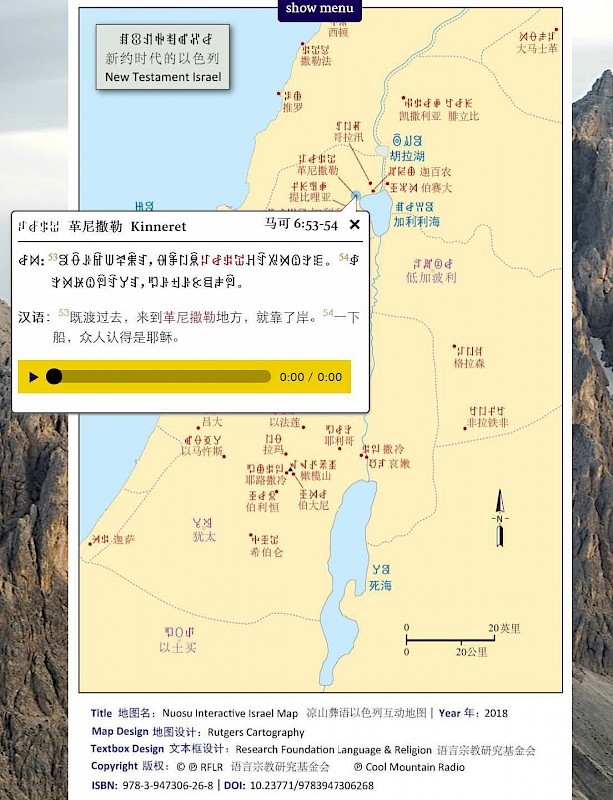 Interactive Israel MapFurthermore, Hans Grass and Michael Siegel of Rutgers Cartography (New Jersey) developed interactive maps of Israel and the Mediterranean Sea, which allow users to track ancient places by the Bible verses that mention these places and to play the corresponding verses.
Interactive Israel MapFurthermore, Hans Grass and Michael Siegel of Rutgers Cartography (New Jersey) developed interactive maps of Israel and the Mediterranean Sea, which allow users to track ancient places by the Bible verses that mention these places and to play the corresponding verses.


